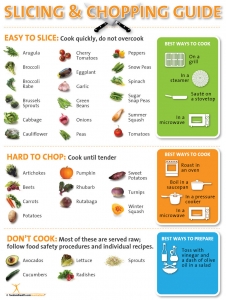10 Must-Have Tools for the Home Kitchen
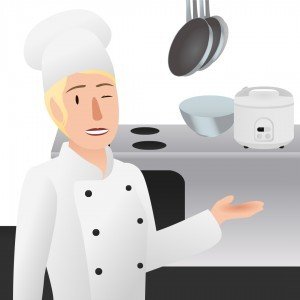 Today I want to talk about tools.Kitchen tools.Doesn't having the right equipment make all the difference? It's that much easier to get a healthful dinner on the table when you're not improvising saucepans or digging through cutlery. In order to help your clients reach their health goals, I highly recommend that you make sure that they've got the essentials for healthful cooking on hand.Which essentials?Well, I'd start with these 10...Kitchen Essential #1: 2-3 Quart SaucepanIt all begins with a saucepan. I've found that a medium one is the most versatile, and boy is it a workhorse in my kitchen. You can use a saucepan to cook rice, soup, pasta, sauce, or even hot cereal. It can also be used to steam veggies.Kitchen Essential #2: Large Soup PotSometimes you need more room than a saucepan can offer, and that's when a large soup pot fits the bill. Get one that is well-insulated in order to cook your food the most evenly. As you might expect, I use large soup pots to make big batches of soup. I also use them when I'm tossing a large amount of pasta in a hearty sauce and need room to get things mixed well. Soup pots are also great for making food like rice or pasta in bulk.
Today I want to talk about tools.Kitchen tools.Doesn't having the right equipment make all the difference? It's that much easier to get a healthful dinner on the table when you're not improvising saucepans or digging through cutlery. In order to help your clients reach their health goals, I highly recommend that you make sure that they've got the essentials for healthful cooking on hand.Which essentials?Well, I'd start with these 10...Kitchen Essential #1: 2-3 Quart SaucepanIt all begins with a saucepan. I've found that a medium one is the most versatile, and boy is it a workhorse in my kitchen. You can use a saucepan to cook rice, soup, pasta, sauce, or even hot cereal. It can also be used to steam veggies.Kitchen Essential #2: Large Soup PotSometimes you need more room than a saucepan can offer, and that's when a large soup pot fits the bill. Get one that is well-insulated in order to cook your food the most evenly. As you might expect, I use large soup pots to make big batches of soup. I also use them when I'm tossing a large amount of pasta in a hearty sauce and need room to get things mixed well. Soup pots are also great for making food like rice or pasta in bulk.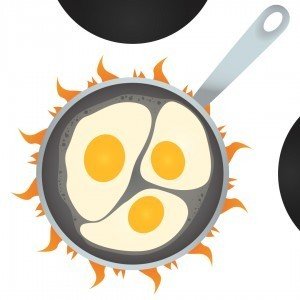 Kitchen Essential #3: Nonstick SkilletThis kitchen essential is especially perfect for breakfast items. I also use it to make rice dishes, chowders, stir fries, and more. Nonstick skillets have a slick surface that makes it easier to cut down on the fat you use to cook, without having to scrape dinner from the pan. A nonstick skillet also allows you to spread out your food to get a nice sear, promoting even browning for a tasty sauté as well.Kitchen Essential #4: Chef's KnifeThis one works in tandem with kitchen essential #5, the paring knife, and kitchen essential #6, the cutting board. A chef's knife is perfect for finely dicing vegetables and cutting lettuce for salads. Use it with melons or large and tougher chopping jobs, like butternut squash. It should feel comfortable in your hand, be easy for you to use, and be sharp. It should also be likely to stay sharp.Kitchen Essential #5: Paring KnifeThe chef knife and paring knife team can tackle just about any cutting job found in a regular kitchen today. Of course there are many choices for various shapes and brands, but these two are a formidable team and are usually inexpensive. Use a paring knife for delicate work like cutting the seeds out of bell peppers. You can also reach for it whenever you're tackling a job that your chef's knife isn't suited for.
Kitchen Essential #3: Nonstick SkilletThis kitchen essential is especially perfect for breakfast items. I also use it to make rice dishes, chowders, stir fries, and more. Nonstick skillets have a slick surface that makes it easier to cut down on the fat you use to cook, without having to scrape dinner from the pan. A nonstick skillet also allows you to spread out your food to get a nice sear, promoting even browning for a tasty sauté as well.Kitchen Essential #4: Chef's KnifeThis one works in tandem with kitchen essential #5, the paring knife, and kitchen essential #6, the cutting board. A chef's knife is perfect for finely dicing vegetables and cutting lettuce for salads. Use it with melons or large and tougher chopping jobs, like butternut squash. It should feel comfortable in your hand, be easy for you to use, and be sharp. It should also be likely to stay sharp.Kitchen Essential #5: Paring KnifeThe chef knife and paring knife team can tackle just about any cutting job found in a regular kitchen today. Of course there are many choices for various shapes and brands, but these two are a formidable team and are usually inexpensive. Use a paring knife for delicate work like cutting the seeds out of bell peppers. You can also reach for it whenever you're tackling a job that your chef's knife isn't suited for.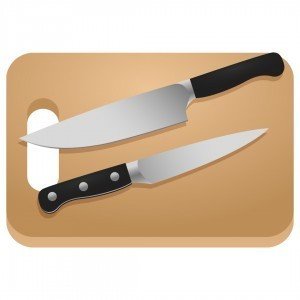 Kitchen Essential #6: Cutting BoardThe mate to a good knife is a good cutting board. There’s a lot of talk in the culinary community about whether wood or plastic boards are better. Personally, I choose plastic boards because they're easier to keep clean. Make sure that the cutting board you choose is sturdy. Before using it, check that the surface it’s on is clean and free of any debris. A stable cutting board is vital to kitchen safety.Kitchen Essential #7: Vegetable PeelerA vegetable peeler can peel any fruit or vegetable. It's indispensable when it comes to prepping produce, and it can shape food as well. Consider making a salad with long and thin carrot slices (peeled by your peeler) or using a peeler to shave off a bit of cheese to accompany an afternoon snack. A peeler is also great for garnishes -- I especially like to use it to shave chocolate over various desserts.Kitchen Essential #8: GraterI think these are really great! Mine comes in handy when I'm working with cheese, root vegetables, fruits, and citrus peels. Get one with holes of various sizes and make sure that it's easy to hold. You wouldn't want to slip and have your food go flying.
Kitchen Essential #6: Cutting BoardThe mate to a good knife is a good cutting board. There’s a lot of talk in the culinary community about whether wood or plastic boards are better. Personally, I choose plastic boards because they're easier to keep clean. Make sure that the cutting board you choose is sturdy. Before using it, check that the surface it’s on is clean and free of any debris. A stable cutting board is vital to kitchen safety.Kitchen Essential #7: Vegetable PeelerA vegetable peeler can peel any fruit or vegetable. It's indispensable when it comes to prepping produce, and it can shape food as well. Consider making a salad with long and thin carrot slices (peeled by your peeler) or using a peeler to shave off a bit of cheese to accompany an afternoon snack. A peeler is also great for garnishes -- I especially like to use it to shave chocolate over various desserts.Kitchen Essential #8: GraterI think these are really great! Mine comes in handy when I'm working with cheese, root vegetables, fruits, and citrus peels. Get one with holes of various sizes and make sure that it's easy to hold. You wouldn't want to slip and have your food go flying.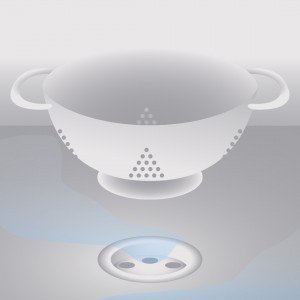 Kitchen Essential #9: ColanderThis one is key for pastas, and anything else you cook in boiling water. Once the food is done, pour the contents of the pot into your colander (which hopefully you arranged in a sturdy spot in your sink while the food was cooking). The liquid will drain right through, leaving the food in the colander. You can also use a colander to clean fresh lettuce, wash berries, rinse canned foods, etc.Kitchen Essential #10: Kitchen SpoonHere is the final chef-approved everyday kitchen utensil: the kitchen spoon. The kitchen spoon is a go-to utensil that can both stir and serve. You can use it like a spoon or a ladle. Pick one that you especially like -- plastic is fine. I recommend getting black utensils because they will show less wear, hide food stains, and just generally look better for longer.I hope this rundown is useful to you! These kitchen staples make great giveaway prizes, subjects for a cooking demonstration, and treats for clients. Oh, and speaking of useful, I want to offer you this free, 2-page PDF handout about knives and cutting boards. It was originally only available as part of the Home Run Cooking Book (a healthful cooking guide for everyone from beginners to professional chefs). Today, I want to make it available to you. I hope it comes in handy!
Kitchen Essential #9: ColanderThis one is key for pastas, and anything else you cook in boiling water. Once the food is done, pour the contents of the pot into your colander (which hopefully you arranged in a sturdy spot in your sink while the food was cooking). The liquid will drain right through, leaving the food in the colander. You can also use a colander to clean fresh lettuce, wash berries, rinse canned foods, etc.Kitchen Essential #10: Kitchen SpoonHere is the final chef-approved everyday kitchen utensil: the kitchen spoon. The kitchen spoon is a go-to utensil that can both stir and serve. You can use it like a spoon or a ladle. Pick one that you especially like -- plastic is fine. I recommend getting black utensils because they will show less wear, hide food stains, and just generally look better for longer.I hope this rundown is useful to you! These kitchen staples make great giveaway prizes, subjects for a cooking demonstration, and treats for clients. Oh, and speaking of useful, I want to offer you this free, 2-page PDF handout about knives and cutting boards. It was originally only available as part of the Home Run Cooking Book (a healthful cooking guide for everyone from beginners to professional chefs). Today, I want to make it available to you. I hope it comes in handy!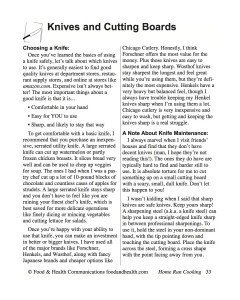 Here are a few more healthful cooking resources from the Nutrition Education Store. Enjoy!
Here are a few more healthful cooking resources from the Nutrition Education Store. Enjoy!